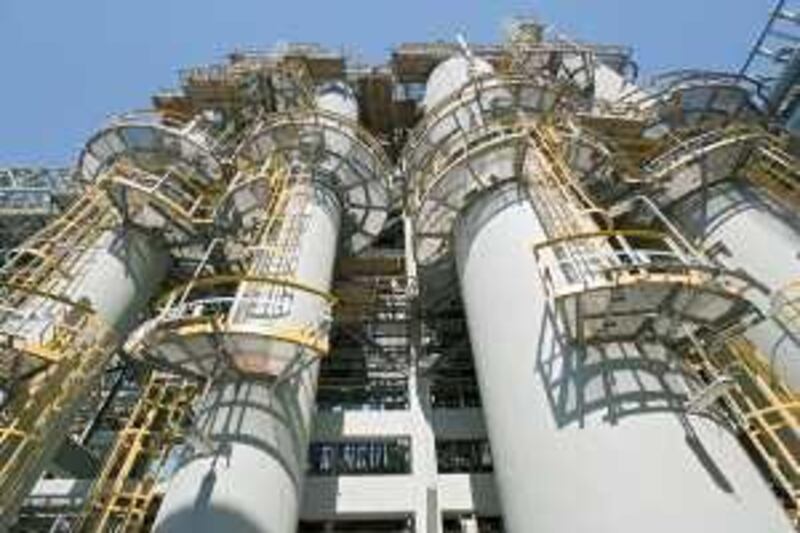RAS LAFFAN, QATAR // Qatar has reached another milestone in its emergence as the world's greatest natural gas power with the opening of a huge plant intended to double its production of liquefied natural gas (LNG). Qatar's expanding LNG exports are expected to propel its economy to 10 per cent growth this year and next, outpacing its Gulf neighbours, whose economies have been constrained by shrinking OPEC oil quotas. Gas will overtake oil this year as Qatar's top revenue source.
"From now on, we will rely mostly on gas production to provide the biggest share of our income," said Abdullah al Attiyah, the Qatari minister of energy, who is also the country's deputy prime minister. The new RasGas plant, which started producing the supercooled gas at the end of July, is one of the largest of its kind in the world, matched only by a plant inaugurated this year by its sister company, Qatargas.
Each of the plants, located in Ras Laffan Industrial City, is capable of producing 7.8 million tonnes per year of LNG to be loaded on to tanker ships. RasGas and Qatargas are units of the state-controlled Qatar Petroleum, which operates in partnership with foreign oil and gas companies that supply the technology for large-scale LNG production. With more RasGas and Qatargas plants under construction, Qatar plans to double its LNG annual export capacity this year to 62 million tonnes and to increase that to 77 million tonnes next year.
Mr al Attiyah said he expected the state to reach its export target by next September. But the emirate, which sits on the planet's third-biggest known reserves of gas, is bringing the world's largest-ever increase in LNG capacity on stream during a glut: the recession has severely cut global gas consumption just as several other countries, notably Australia, are developing rival export projects. ExxonMobil, which has a 30 per cent interest in each of Qatar's two newest production facilities, nevertheless expects the LNG business to remain profitable in the face of intense global competition. That is because the massive plants bring unprecedented economies of scale.
"The key is to have the lowest cost of supply and to have the option to get into the best market. This is what RasGas and Qatargas have positioned themselves to do," said Mark Albers, a senior vice president of ExxonMobil. Mr al Attiyah believes that in the longer term, gas demand will surge as the world economy improves. "Demand will be huge beyond 2012 to 2013. The LNG from Australia and Qatar will not cover all this demand," he said.
Not only can Qatar's big new LNG plants chill gas more efficiently than smaller facilities, they can also accommodate the latest generation of LNG supertankers, which can transport the fuel for longer distances at lower cost than smaller vessels. One of those ships, Al Dafna, which is owned by RasGas, is roughly the size of an aircraft carrier and is currently the biggest LNG tanker in the world. Docked at Ras Laffan on Monday, it was taking on as much as 260,000 cubic metres of gas for delivery to South Korea. The ship has its own gas re-liquefaction plant on board, extending its range.
Asia remains one of Qatar's most lucrative LNG markets, and the emirate is now seeking to develop its gas trade with China. "I am a big believer that the Chinese market will be one of the biggest in the world," Mr al Attiyah said. Already Qatar has had success in adding China to its growing list of customers. Under provisions of flexible sales contracts, Qatargas has in recent months diverted 5 million tonnes of LNG from the US market to higher paying Chinese customers, Mr al Attiyah disclosed.
Analysts predicted that Qatar would move aggressively to lock up the Chinese market ahead of other potential suppliers, including Australia and Iran. "It is a relationship that is not going to be mutually exclusive, but it is going to get deeper," Al Troner, the president of Asia Pacific Energy Consulting in Houston, told Reuters. "China will always take some LNG, and I believe that commonly talked about ceiling of about 30 million metric tonnes per year is pretty likely. They will have enormous gas needs."
The International Energy Agency predicts that global demand for natural gas will increase by roughly 50 per cent by 2030. tcarlisle@thenational.ae





